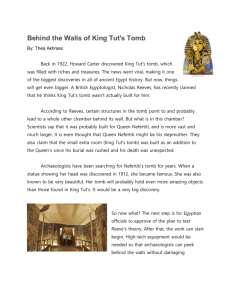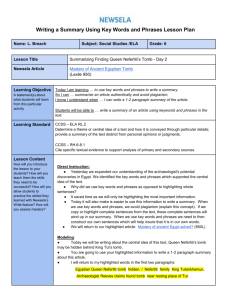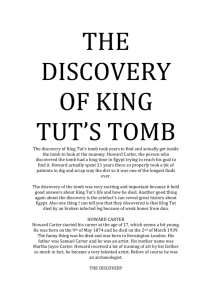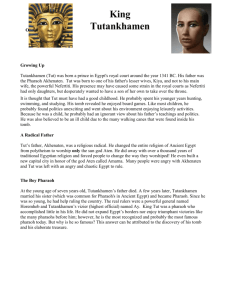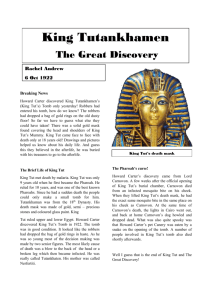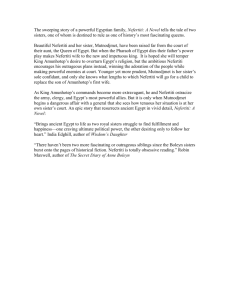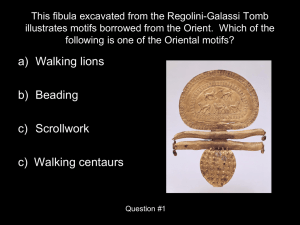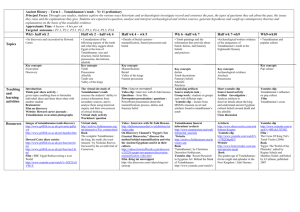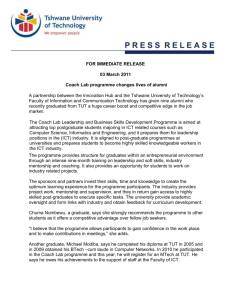BreachMSEgyptKeywords
advertisement
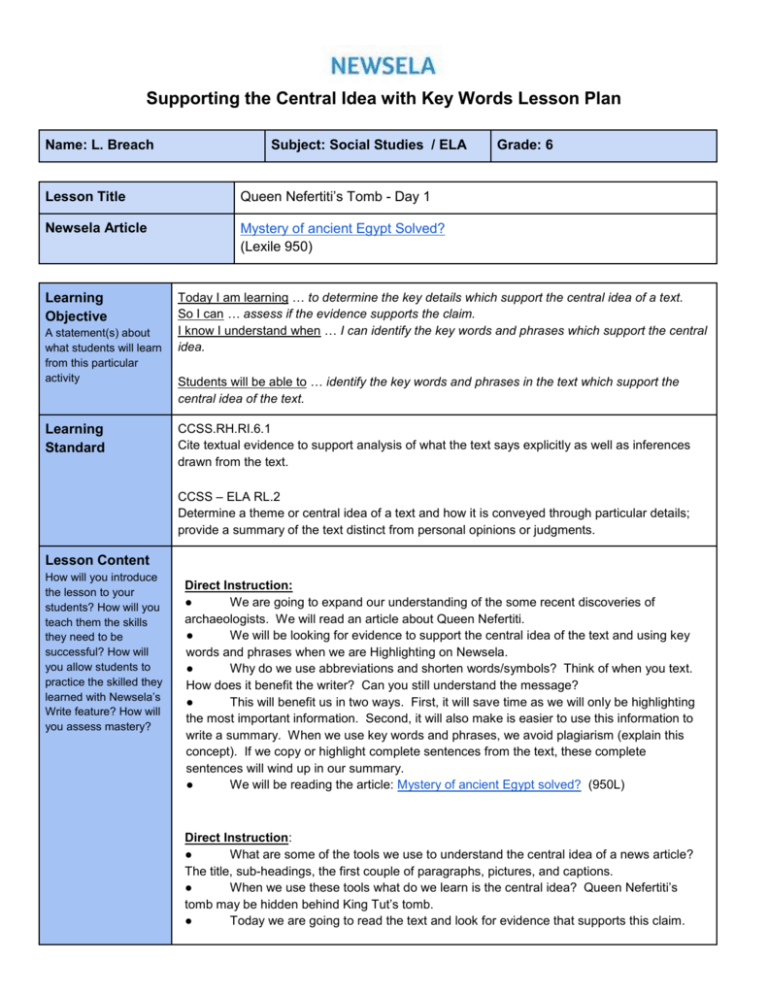
Supporting the Central Idea with Key Words Lesson Plan Name: L. Breach Subject: Social Studies / ELA Lesson Title Queen Nefertiti’s Tomb - Day 1 Newsela Article Mystery of ancient Egypt Solved? (Lexile 950) Learning Objective A statement(s) about what students will learn from this particular activity Learning Standard Grade: 6 Today I am learning … to determine the key details which support the central idea of a text. So I can … assess if the evidence supports the claim. I know I understand when … I can identify the key words and phrases which support the central idea. Students will be able to … identify the key words and phrases in the text which support the central idea of the text. CCSS.RH.RI.6.1 Cite textual evidence to support analysis of what the text says explicitly as well as inferences drawn from the text. CCSS – ELA RL.2 Determine a theme or central idea of a text and how it is conveyed through particular details; provide a summary of the text distinct from personal opinions or judgments. Lesson Content How will you introduce the lesson to your students? How will you teach them the skills they need to be successful? How will you allow students to practice the skilled they learned with Newsela’s Write feature? How will you assess mastery? Direct Instruction: ● We are going to expand our understanding of the some recent discoveries of archaeologists. We will read an article about Queen Nefertiti. ● We will be looking for evidence to support the central idea of the text and using key words and phrases when we are Highlighting on Newsela. ● Why do we use abbreviations and shorten words/symbols? Think of when you text. How does it benefit the writer? Can you still understand the message? ● This will benefit us in two ways. First, it will save time as we will only be highlighting the most important information. Second, it will also make is easier to use this information to write a summary. When we use key words and phrases, we avoid plagiarism (explain this concept). If we copy or highlight complete sentences from the text, these complete sentences will wind up in our summary. ● We will be reading the article: Mystery of ancient Egypt solved? (950L) Direct Instruction: ● What are some of the tools we use to understand the central idea of a news article? The title, sub-headings, the first couple of paragraphs, pictures, and captions. ● When we use these tools what do we learn is the central idea? Queen Nefertiti’s tomb may be hidden behind King Tut’s tomb. ● Today we are going to read the text and look for evidence that supports this claim. We are going to only highlight KEY WORDS and PHRASES. This is important because tomorrow we are going to write a summary and we want this summary to be in our own words. Modeling: ● I will read the first 2 paragraphs of the article aloud. ● I will underline the key words needed to understand the central idea, Queen Nefertiti’s tomb may be hidden behind King Tut’s tomb. The ancient Egyptian Queen Nefertiti has long been at the center of a mystery. For years, archaeologists have wondered where her tomb might be hidden. Nefertiti belonged to the family line of the famous King Tutankhamun, better known as King Tut. Indeed, some believe she was Tut's mother. While the other royals in her line are all accounted for, Nefertiti is still missing. ● Notice that I am leaving out some of the smaller words in the sentences. ● When I look for key words and phrases, I will often leave out what may be considered interesting information such as “some believe she was Tut’s mother.” We often remember these interesting facts and this is not essential in supporting the main claim. ● Now let’s do the next 2 paragraphs together as a class. Articulate the difference between possibly interesting information and essential information. “Secret Doors In A King's Tomb Now, however, an archaeologist named Nicholas Reeves claims he has found her secret tomb. He says it is in the Valley of the Kings, hidden just beyond a wall near the resting place of Tut. Reeves' theory is based on a detailed study of the walls of Tutankhamun's tomb. Using radar scans, Reeves was able to see what the walls looked like beneath their layers of paint. He found a number of cracks that he believes may indicate two previously concealed doors. ● ● Notice I included the word “may” to show that they are not positive and still need to investigate further. When I read the words I’ve highlighted, did I capture most important information? Is this sufficient to help me understand key ideas? This is a good test for making sure I have enough information. Student Practice: ● After modeling together students will go to their individual Reading Level to complete the reading and assignment. ● Directions: (Teacher Note: Share as instructions on Newsela article) ○ Highlight in YELLOW the key words and phrases that support the central idea. Remember to use the sub-headings to help guide you. Do not be surprised if there are large areas you do NOT highlight. ● Monitor what students are highlighting and assist where needed. Guided Questions: ● How does this support the central idea? ● Can you shorten what you highlighted? ● Did I highlight enough to communicate the key details? Assessment: ● Share your highlights with the class. Discuss answers and differences. ● Students will show comprehension mastery by having 80% similar highlights as teacher. Accommodations What scaffolds can be included to support learners? Can you anticipate different reading level for students? Extensions How can you support high level learners? Can you anticipate reading level and Writing Prompt to challenge? ● Work with small groups and discuss sections of the text. What is the difference between interesting information and evidence that supports central idea? Make sure that the central idea is written in front of students. ● Provide on-task focusing prompts. ● Assign leveled articles based on appropriate performance reading levels. ● Increase Reading Level (1140 and higher based on appropriate performance reading levels). ● Assign second article: Remains of 4 leaders identified at early English settlement of Jamestown (Lexile 1130) ○ ○ Have students continue to practice skill Can they identify the central idea independently?
